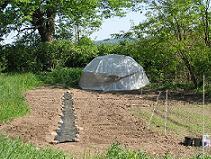First Stage
The Root Center will begin with a small acreage farmed entirely through volunteer support using hand tools and donated/borrowed farming equipment. The Root Center will demonstrate green building technology through a 30-foot diameter geodesic dome tent for use as a base of operations. We will build small greenhouses using innovative, winterized, greenhouse designs, incorporating hydroponics technology for year-round crop production. In cooperation with Todd Ecological, The Root Center will construct an aquaponics system to generate food and possibly energy. The Root Center will also serve as a demonstration site for Allard Engineering’s prototype vertical axis wind generator for its day to day power needs, and will incorporate small solar panels to automate the greenhouses’ climate control mechanisms. Grow wheel technology can be incorporated during the first stage, demonstrating just how much quality food can be grown in the smallest of spaces (dependent on funding.) Funding for The Root Center in the first stage will be mainly through grants, donations, sales of a small percentage of produce, concert series’, and other fundraisers. Benefits from The Root Center during the first stage include (but are not limited to):
- Donations of a majority of the produce to local food shelves.
- Hands-on learning about sustainable agriculture, clean energy, organic farming and green architecture for the public.
- A focal point and living laboratory for integration of emerging technology, which can lead to internship opportunities for students.
- Publications, instructions and newsletters designed toward helping citizens incorporate green architecture, clean energy and organic gardening at their place of residence.
